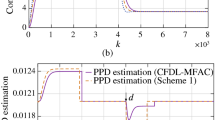Abstract
This study proposes a hybrid controller by combining a proportional-integral-derivative (PID) control and a model reference adaptive control (MRAC), which named as PID + MRAC controller. The convergence performances of the PID control, MRAC, and hybrid PID + MRAC are also compared. Through the simulation in Matlab, the results show that the convergence speed and performance of the MRAC and the PID + MRAC controller are better than those of the PID controller. In addition, the convergence performance of the hybrid control is better than that of the MRAC control.
Similar content being viewed by others
References
Jafarov E M, Parlak M N A, Istefanopulos Y. A new variable structure PID-controller design for robot manipulators. IEEE Transactions on Control Systems Technology, 2005, 13(1): 122–130
Landau Y D. Adaptive Control: The Model Reference Approach. New York: Marcel Dekker, 1979
Dubowsky S, Desforges D. The application of model-referenced adaptive control to robotic manipulators. Journal of Dynamic Systems, Measurement, and Control, 1979, 101(3): 193–200
Cao C, Hovakimyan N. Design and analysis of a novel L1 adaptive control architecture with guaranteed transient performance. IEEE Transactions on Automatic Control, 2008, 53(2): 586–591
Jain P, Nigam M J. Design of a model reference adaptive controller using modified MIT rule for a second order system. Advance in Electronic and Electric Engineering, 2013, 3(4): 477–484
Nguyen N T, Krishnakumar K, Boskovic J. An optimal control modification to model-reference adaptive control for fast adaptation. In: Proceedings of AIAA Guidance, Navigation and Control Conference and Exhibit. Honolulu, 2008, 1–20
Idan M, Johnson M D, Calise A J. A hierarchical approach to adaptive control for improved flight safety. Journal of Guidance, Control, and Dynamics, 2002, 25(6): 1012–1020
Valente A, Mazzolini M, Carpanzano E. An approach to design and develop reconfigurable control software for highly automated production systems. International Journal of Computer Integrated Manufacturing, 2015, 28(3): 321–336
Landau I D, Lozano R, M’Saad M, et al. Communications and Control Engineering. London: Springer, 2011
Horowitz R, Tomizuka M. An adaptive control scheme for mechanical manipulators—Compensation of nonlinearity and decoupling control. Journal of Dynamic Systems, Measurement, and Control, 1986, 108(2): 127–135
Sadegh N, Horowitz R. Stability and Robustness Analysis of a Class of Adaptive Controllers for Robotic Manipulators. International Journal of Robotics Research, 1990, 9(3): 74–92
Craig J J. Introduction to Robotics: Mechanics and Control. 3rd ed. Upper Saddle River: Addison Wesley, 2005
Author information
Authors and Affiliations
Corresponding author
Rights and permissions
About this article
Cite this article
Zhang, D., Wei, B. Convergence performance comparisons of PID, MRAC, and PID + MRAC hybrid controller. Front. Mech. Eng. 11, 213–217 (2016). https://doi.org/10.1007/s11465-016-0386-x
Received:
Accepted:
Published:
Issue Date:
DOI: https://doi.org/10.1007/s11465-016-0386-x




